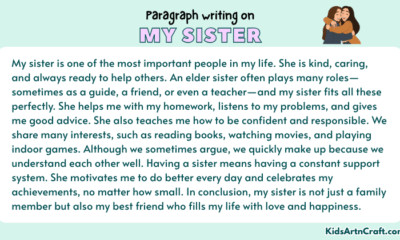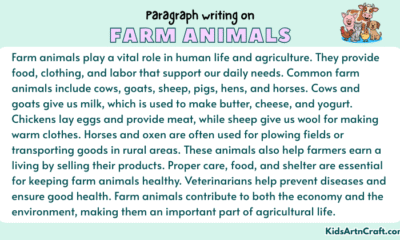Paragraph Writing
Paragraph on Labour Day
In this lesson, we’ll practice crafting “Labour Day” paragraphs in four styles — Expository, Persuasive, Descriptive, and Narrative — while applying paragraph frameworks such as PEEL, TEEL, TEXAS, and the Hamburger Method.
Most of our paragraphs are in 150 to 200 words. You can also find longer paragraphs (in 300 words) on ‘Labour Day’ or essays on the same topic on the web.
Different Styles of Paragraphs on ‘Labour Day’
1. Expository Paragraph on Labour Day (Explains with Facts)
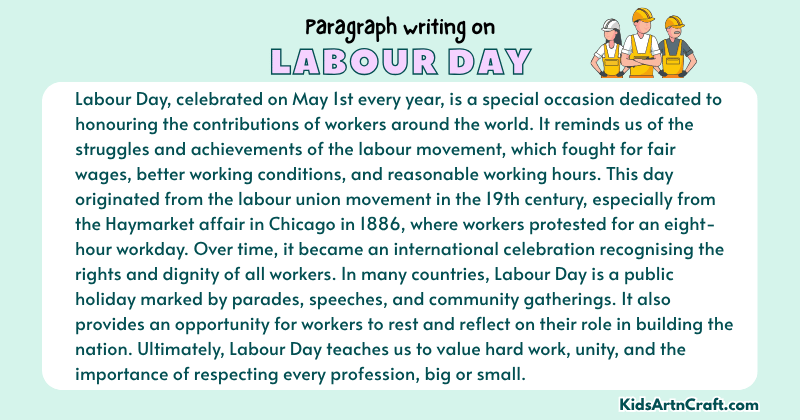
Labour Day, celebrated on May 1st every year, is a special occasion dedicated to honouring the contributions of workers around the world. It reminds us of the struggles and achievements of the labour movement, which fought for fair wages, better working conditions, and reasonable working hours. This day originated from the labour union movement in the 19th century, especially from the Haymarket affair in Chicago in 1886, where workers protested for an eight-hour workday. Over time, it became an international celebration recognising the rights and dignity of all workers. In many countries, Labour Day is a public holiday marked by parades, speeches, and community gatherings. It also provides an opportunity for workers to rest and reflect on their role in building the nation. Ultimately, Labour Day teaches us to value hard work, unity, and the importance of respecting every profession, big or small.
2. Persuasive Paragraph on Labour Day (Tries to Convince You)
Labour Day should be celebrated with great respect and enthusiasm because it recognises the tireless efforts of workers who keep our world moving. Every building, road, school, and hospital exists because of the dedication of hardworking men and women. However, many workers still face unfair treatment and low wages, even today. Celebrating Labour Day is not just about enjoying a holiday—it is about acknowledging its importance and supporting workers’ rights. Governments and organisations must ensure safe workplaces, fair pay, and equal opportunities for everyone. Students and citizens should also take time to understand the value of labour and express gratitude to those who make our lives comfortable. By celebrating Labour Day meaningfully, we can create a more respectful and just society where every worker feels appreciated. Let us all take this day to honour their hard work and promise to stand up for fairness and dignity in all professions.
3. Descriptive Paragraph on Labour Day (Paints a Picture with Words)
On Labour Day morning, the streets fill with the sound of music and cheerful voices as parades march proudly through towns and cities. Colourful banners wave high, celebrating the strength and unity of workers. People carry flags, sing songs, and display posters with messages of equality and respect. In schools, students make drawings and perform skits about the value of hard work. Families gather to enjoy picnics or simply take a well-deserved rest. The air feels lighter because everyone knows this day is dedicated to those whose efforts keep society alive—teachers, farmers, doctors, factory workers, and many more. Speeches remind people of the struggles faced by labourers in the past and the importance of maintaining their rights. The joy and gratitude shared on Labour Day create a sense of pride and togetherness. It is truly a day that celebrates both the spirit and dignity of work.
4. Narrative Paragraph on Labour Day (Tells a Story)
Last year on Labour Day, my school organised a special event to honour the workers who keep our school clean and safe. Early in the morning, we decorated the assembly hall with red and white balloons and made posters that read, “Respect Every Worker.” When the workers arrived, we greeted them with claps and presented handmade cards. Our principal gave a heartfelt speech about the importance of their hard work. I remember one worker, Mr Ramesh, smiling proudly as he shared his story about working for the school for over twenty years. We also sang songs and performed a short play showing how the labour movement helped secure workers’ rights. Later, we served snacks and talked with them about their daily duties. That day taught me that Labour Day is not just a holiday—it’s a moment to show appreciation and kindness to those who make our lives easier every single day.
‘Labour Day‘ Paragraphs in Different Structured Methods
1. Labour Day Paragraph Writing with PEEL Method
PEEL Method (Point, Evidence, Explanation, Link)
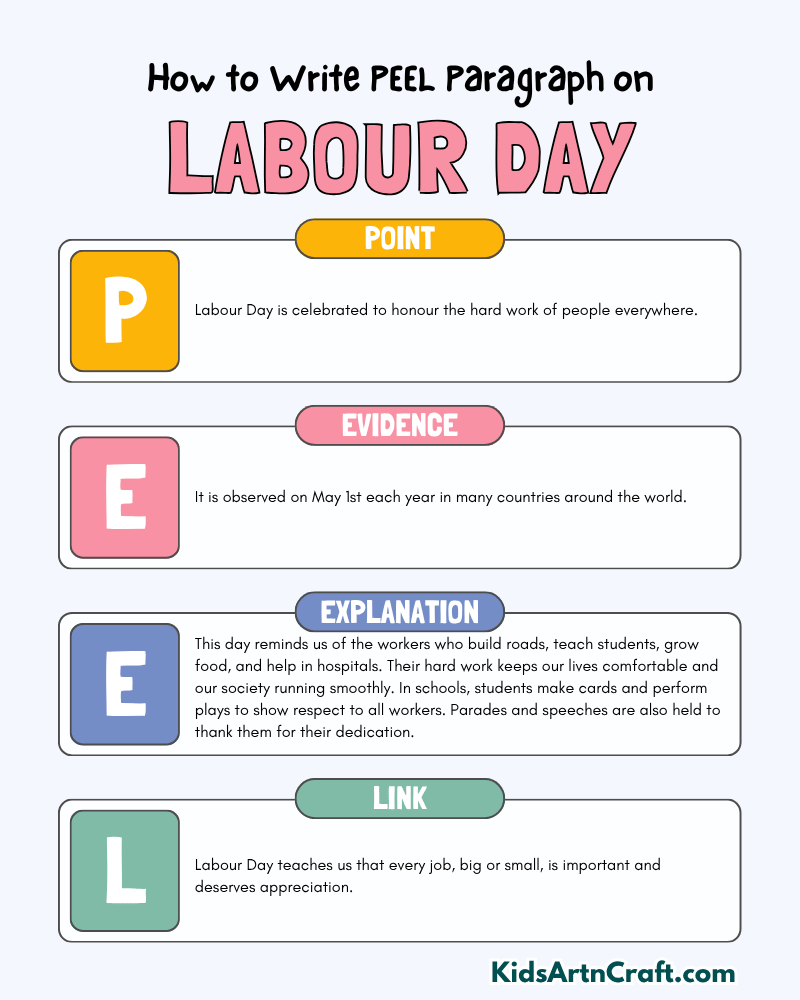
Point: Labour Day is celebrated to honour the hard work of people everywhere.
Evidence: It is observed on May 1st each year in many countries around the world.
Explanation: This day reminds us of the workers who build roads, teach students, grow food, and help in hospitals. Their hard work keeps our lives comfortable and our society running smoothly. In schools, students make cards and perform plays to show respect to all workers. Parades and speeches are also held to thank them for their dedication.
Link: Labour Day teaches us that every job, big or small, is important and deserves appreciation.
2. Labour Day Paragraph Writing with TEEL Method
TEEL Method (Topic, Evidence, Explanation, Link)
Topic: Labour Day is a special day to recognise and thank workers for their efforts.
Evidence: Workers once fought for better hours, fair wages, and safer workplaces, and Labour Day honours their victory and dedication.
Explanation: It is celebrated on May 1st every year in many countries to remember the labour movement and its struggles for fair working conditions.
Link: By celebrating Labour Day, we learn to value the effort of every worker who contributes to our world, from teachers and doctors to farmers and builders.
3. Labour Day Paragraph Writing with the TEXAS Method
TEXAS Method (Topic, Example, Explanation, Analysis, Summary/Significance)
Topic: Labour Day celebrates the achievements and hard work of people in all professions.
Example: For example, schools organise events where students thank the staff who clean, cook, and help daily. Some communities also hold parades and rallies to honour workers.
Explanation: It reminds us of the workers’ fight for fair treatment and better working hours in the past.
Analysis: These celebrations help everyone understand that each job is valuable and deserves respect.
Summary: Labour Day encourages us to be grateful for workers and to treat all professions equally.
4. Labour Day Paragraph Writing with Hamburger Method
Hamburger Method (Top Bun, The Fillings, Bottom Bun)
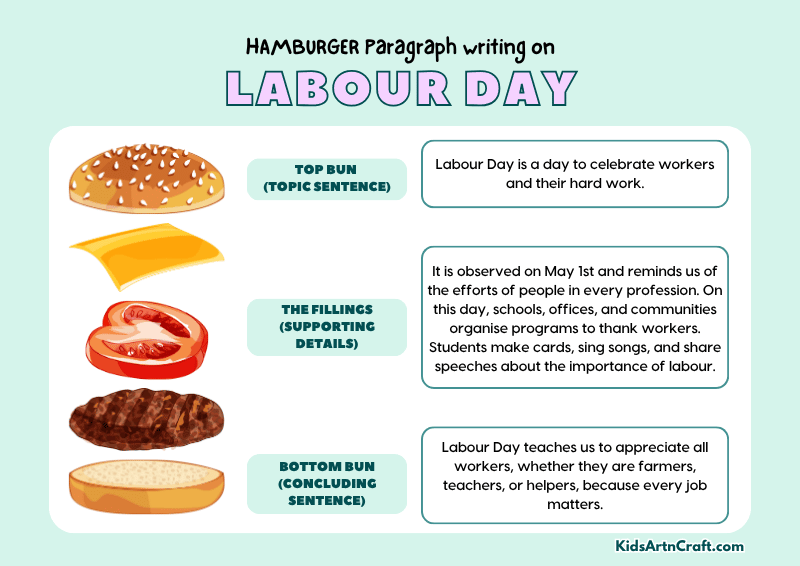
Top Bun (Topic Sentence):
Labour Day is a day to celebrate workers and their hard work.
The Fillings (Supporting Details):
It is observed on May 1st and reminds us of the efforts of people in every profession. On this day, schools, offices, and communities organise programs to thank workers. Students make cards, sing songs, and share speeches about the importance of labour.
Bottom Bun (Concluding Sentence):
Labour Day teaches us to appreciate all workers, whether they are farmers, teachers, or helpers, because every job matters.
Hope you liked these paragraphs on ‘Labour Day’. Don’t forget to join the Telegram group for FREE Printables.



